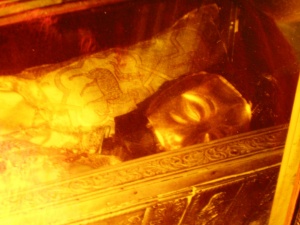Difference between revisions of "John the Russian"
(rm copyrighted material, added intro, ext. links) |
m |
||
| Line 1: | Line 1: | ||
[[Image:JohnRussian01.JPG|thumb|right|St. John the Russian]] | [[Image:JohnRussian01.JPG|thumb|right|St. John the Russian]] | ||
[[Image:JohnRussian02.JPG|thumb|right|Close up of the saint's relics]] | [[Image:JohnRussian02.JPG|thumb|right|Close up of the saint's relics]] | ||
| + | |||
| + | The holy Saint '''John the Russian''' (1690-1730) was enslaved by the Turks, but lived his life in holy humility and miracles. His [[feast day]] is commemorated by the Church on [[May 27]]. | ||
{{cleanup}} | {{cleanup}} | ||
| − | |||
| − | |||
==Monastery of St. John the Russian (Euboea)== | ==Monastery of St. John the Russian (Euboea)== | ||
| − | The [[relics]] were brought to [[w:Euboea|Euboea]] by refugees from [[w:Ürgüp|Ürgüp]] | + | The [[relics]] were brought to the village of Prokopion in [[w:Euboea|Euboea]] by refugees from [[w:Ürgüp|Ürgüp]] in [[w:Cappadocia|Cappadocia]], after the Asia Minor Disaster of 1922-24. For several decades the relics were in the church of Ss. Constantine and Helen at New Prokopion, Euboia, and in 1951 they were transferred to a new church dedicated to St John the Russian (within the new [[Monastery of St. John the Russian (Euboea)|Monastery of Saint John the Russian]]). St. John's body is small, and he is clothed in a garment similar to an altar server. His face is dark and is covered by a gold mask; one of his exposed hands is also quite dark. Thousands of pilgrims flock here from all the corners of Greece, particularly on his feast day (May 27). |
St. John the Russian is widely venerated on [[Mount Athos]], particularly in the Russian monastery of St. Panteleimon. | St. John the Russian is widely venerated on [[Mount Athos]], particularly in the Russian monastery of St. Panteleimon. | ||
Revision as of 04:48, July 1, 2008
The holy Saint John the Russian (1690-1730) was enslaved by the Turks, but lived his life in holy humility and miracles. His feast day is commemorated by the Church on May 27.
Monastery of St. John the Russian (Euboea)
The relics were brought to the village of Prokopion in Euboea by refugees from Ürgüp in Cappadocia, after the Asia Minor Disaster of 1922-24. For several decades the relics were in the church of Ss. Constantine and Helen at New Prokopion, Euboia, and in 1951 they were transferred to a new church dedicated to St John the Russian (within the new Monastery of Saint John the Russian). St. John's body is small, and he is clothed in a garment similar to an altar server. His face is dark and is covered by a gold mask; one of his exposed hands is also quite dark. Thousands of pilgrims flock here from all the corners of Greece, particularly on his feast day (May 27).
St. John the Russian is widely venerated on Mount Athos, particularly in the Russian monastery of St. Panteleimon.
External links
Categories > Church History
Categories > Church History
Categories > Church History
Categories > Church History
Categories > Liturgics > Feasts
Categories > Liturgics > Feasts
Categories > Liturgics > Feasts
Categories > Liturgics > Feasts
Categories > People > Saints
Categories > People > Saints > Greek Saints
Categories > People > Saints > Russian Saints
Categories > People > Saints > Saints by century > 18th-century saints

